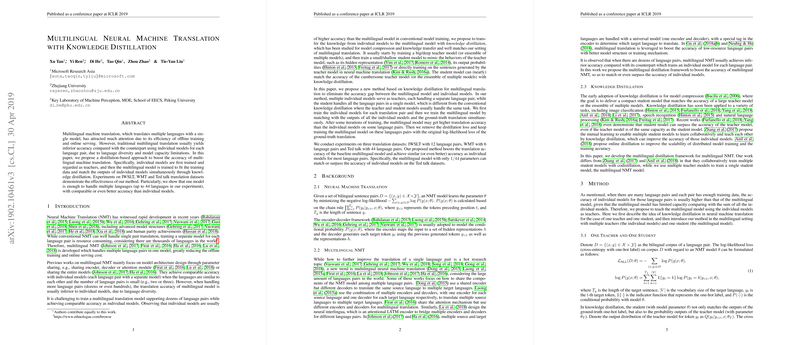Multilingual Neural Machine Translation with Knowledge Distillation: An Overview
In the domain of neural machine translation (NMT), the task of multilingual translation—wherein a single model handles multiple language pairs—has gained considerable interest due to its computational efficiency. The complexity arises from managing linguistic diversity and model capacity constraints, often leading to inferior performance compared to models tailored for individual language pairs. The paper "Multilingual Neural Machine Translation with Knowledge Distillation" addresses this challenge by introducing a distillation-based method aimed at enhancing the accuracy of multilingual translation models.
Core Contributions
The primary contribution of this research is the application of knowledge distillation to transfer knowledge from high-performing individual models to a single, more efficient multilingual model. In essence, this involves treating the specialized models as 'teachers' and the aggregated multilingual model as the 'student.' The student model is trained to replicate the outputs of the teacher models, thereby improving its translation accuracy across multiple languages simultaneously.
By implementing knowledge distillation, the authors propose a structured methodology that leverages the success of individual models trained on specific language pairs. The multilingual model undergoes training not only with the actual translation dataset but also seeks to mimic the outputs of the more tailored teacher models. This dual-objective training regimen helps bridge the accuracy gap that typically exists between multilingual models and their individual counterparts.
Empirical Evaluation
The efficacy of the proposed approach is demonstrated through experiments on several benchmarks, including IWSLT, WMT, and TED talk datasets, spanning up to 44 language pairs. These cover many-to-one and one-to-many translation settings. The results are compelling, showing that the distillation-based multilingual model achieves comparable or superior performance versus individual models. Specifically, the TED talk dataset experiments highlight the model’s ability to manage 44 languages with an accuracy that rivals that of specialized models, maintaining efficiency by using only 1/44th of the parameters typically required for individual models.
A notable empirical finding is the consistent improvement in BLEU scores with the proposed method across nearly all language pairs in the datasets tested. Importantly, the paper presents strong numerical evidence showing that multilingual training augmented with distillation is not only viable but advantageous for languages with smaller datasets, thereby reducing the requirement for extensive individual training corpora.
Theoretical and Practical Implications
The utilization of knowledge distillation in this context provides a nuanced mechanism for enhancing model generalization, potentially leading to better handling of unseen data—a critical requirement in multilingual contexts where data scarcity for certain language pairs is common. Furthermore, the paper investigates selective distillation to prevent poorer teachers from deteriorating the student's performance.
In practical terms, this work suggests a method for constructing efficient translation systems that both optimize computational resources and deliver robust performance. It opens pathways for creating broadly applicable NMT systems that reduce memory and processing overhead while maintaining high translation quality across diverse linguistic constructs.
Future Directions
Building on the implications of this paper, future work could explore expanding this distillation approach to more complex network architectures and larger sets of language pairs, encompassing additional language family complexities and deeper semantic variations. Another prospective research direction is enhancing interoperability in multilingual models, potentially through novel sharing strategies beyond current parameter sharing practices.
Overall, the integration of knowledge distillation within multilingual NMT frameworks represents a significant step toward more sustainable, accurate, and scalable translation systems, offering valuable insights and methodologies for ongoing research within the AI and machine translation communities.
